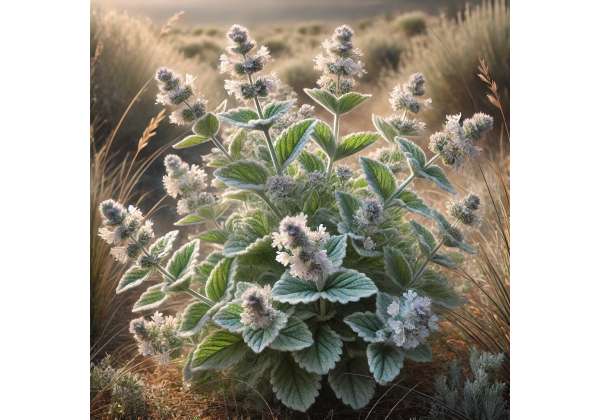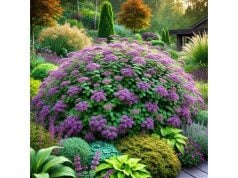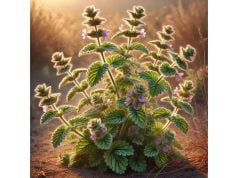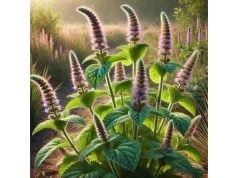
Hoary Mountain Mint is an extraordinary herb celebrated for its robust flavor, aromatic profile, and impressive therapeutic benefits. This remarkable mint variety, with its frosted, silver-green leaves and delicate, tubular blossoms, has been prized both in traditional remedies and modern herbal applications. Known for supporting digestive health, respiratory function, and overall well-being, it has earned a solid reputation among herbal enthusiasts. In this comprehensive guide, we delve into its botanical characteristics, active compounds, health benefits, practical applications, and cutting-edge scientific research, empowering you to explore and safely integrate this versatile herb into your lifestyle.
Table of Contents
- Botanical Overview and Plant Identification
- Chemical Constituents and Key Active Compounds
- Health Benefits and Essential Qualities
- Applications, Uses, and Safety Precautions
- Research Insights and Key Scientific Findings
- FAQ
Botanical Overview and Plant Identification
Hoary Mountain Mint is a striking perennial herb belonging to the Lamiaceae family, renowned for its aromatic essential oils and therapeutic properties. This herb, distinguished by its frosted, velvety foliage and modest stature, typically grows to a height of 30–60 cm. Its silvery-green, ovate to lanceolate leaves—often with finely serrated margins—exude a refreshing minty aroma when gently crushed. In summer, clusters of small, tubular flowers bloom in hues ranging from pale purple to white, attracting bees, butterflies, and other beneficial pollinators.
Taxonomy and Classification:
Hoary Mountain Mint’s classification is as follows:
- Kingdom: Plantae
- Order: Lamiales
- Family: Lamiaceae
- Genus: (Often associated with the Pycnanthemum group)
- Species: Typically recognized as a unique variant within mountain mints
Distinctive Morphological Characteristics:
- Leaf Texture & Appearance: The hallmark of this herb is its hoary, slightly fuzzy leaves. This dense covering of fine hairs not only imparts a distinctive silvery sheen but also helps the plant conserve moisture in arid, high-altitude conditions.
- Stem and Growth Form: The erect, slender stems support the lush foliage and offer an elegant, architectural quality to the plant.
- Floral Attributes: The inflorescences, composed of numerous small, tubular blossoms, are arranged in loose clusters. Their subtle coloration and soft hues enhance the plant’s ornamental appeal while serving as a magnet for pollinators.
Growth Conditions and Habitat:
Native to rocky, mountainous regions, Hoary Mountain Mint thrives in well-drained, slightly alkaline soils. It flourishes under full sun exposure, though it tolerates partial shade. Its adaptability to harsh climates—where moisture is scarce and temperatures can be low—makes it a favored candidate for both wild growth and controlled cultivation. Gardeners appreciate its resilience, noting that minimal irrigation is required once the plant is established, and its natural aroma serves as a deterrent against common pests.
Cultivation and Propagation:
Cultivating Hoary Mountain Mint involves careful attention to environmental conditions:
- Soil Requirements: Well-aerated, slightly alkaline soil with excellent drainage is ideal.
- Sunlight: Full to partial sunlight ensures robust growth.
- Watering Needs: Moderate watering is sufficient once the plant is well-established, as its adapted leaf structure minimizes water loss.
- Propagation Methods: Propagation is typically achieved through seed sowing in early spring or via cuttings taken during the warmer months. Regular pruning helps maintain a compact form and encourages new growth.
Ecological and Historical Significance:
In its natural habitat, Hoary Mountain Mint plays a vital ecological role. The plant’s aromatic flowers are essential for attracting a diverse array of pollinators, thus supporting local biodiversity. Historically, indigenous communities have harnessed its medicinal properties—using infusions and extracts to alleviate ailments such as digestive discomfort, respiratory issues, and inflammatory conditions. Today, both herbal practitioners and culinary experts continue to explore its applications, integrating its unique flavor and health-promoting attributes into modern recipes and therapeutic regimens.
Adaptations and Environmental Resilience:
One of the plant’s most fascinating adaptations is its ability to conserve moisture through a dense covering of fine hairs on its leaves. This adaptation not only provides a protective barrier against arid conditions but also contributes to the herb’s unique flavor profile when the leaves are used fresh or dried. Additionally, its natural pest resistance minimizes the need for chemical pesticides, aligning well with organic gardening practices.
Visual Identification Markers:
For those seeking to identify Hoary Mountain Mint in the wild or in a garden setting, key markers include:
- Foliage: Fuzzy, silver-green leaves with a hoary appearance.
- Flowers: Small, tubular blossoms arranged in airy clusters.
- Aroma: A distinct minty fragrance that intensifies when the leaves are rubbed.
- Stem Structure: Slender, erect stems that contribute to its overall delicate yet robust form.
Overall, the botanical profile of Hoary Mountain Mint not only emphasizes its ornamental charm but also underlines its practical benefits. Whether you’re a botanist, herbalist, or gardening enthusiast, understanding these plant characteristics is essential for both successful cultivation and optimal utilization. Its robust nature and unique adaptations make it a resilient herb, capable of thriving in less-than-ideal conditions while offering a wealth of benefits—both visually and medicinally. This comprehensive profile sets the stage for exploring the herb’s chemical makeup and the active compounds that contribute to its renowned benefits.
Chemical Constituents and Key Active Compounds
Hoary Mountain Mint is not just admired for its aesthetic appeal and aroma—it is also a treasure trove of potent bioactive compounds that underpin its many health benefits. The herb’s chemical profile is complex, with each constituent playing a distinct role in its therapeutic actions. Below is an in-depth exploration of the primary active compounds found in Hoary Mountain Mint:
- Menthol
Known for its cooling and soothing properties, menthol is one of the standout compounds in Hoary Mountain Mint. It acts as a natural analgesic and anti-inflammatory agent, providing relief from muscle aches and respiratory congestion. Menthol also enhances the herb’s aromatic profile, making it popular in both medicinal and culinary applications. - Menthone
Menthone contributes significantly to the mint’s characteristic fragrance and flavor. It exhibits anti-inflammatory and mild analgesic effects, which can help alleviate minor pains and discomforts. Menthone also supports digestive processes by promoting smooth muscle relaxation in the gastrointestinal tract. - Isomenthone
A close relative of menthone, isomenthone plays a complementary role in the herb’s overall efficacy. It enhances the cooling sensation provided by menthol and may aid in reducing inflammation. This compound is also recognized for its potential to improve blood circulation, which can contribute to overall cardiovascular health. - Pulegone
Although present in smaller quantities, pulegone is an essential component of Hoary Mountain Mint’s chemical makeup. It possesses notable aromatic qualities and, in controlled amounts, may contribute to the herb’s digestive benefits. However, pulegone must be used cautiously due to its potential toxicity at higher concentrations, underscoring the importance of proper dosage and preparation methods. - Limonene
Limonene is a naturally occurring terpene known for its antioxidant and mood-enhancing properties. It helps neutralize free radicals, reducing oxidative stress, and may support overall immune function. Limonene’s bright, citrus-like aroma also adds a refreshing note to the herb’s scent profile. - Cineole (Eucalyptol)
Cineole is recognized for its ability to support respiratory health. Its expectorant properties help clear mucus and ease breathing, making it particularly beneficial for individuals with colds or respiratory congestion. Additionally, cineole exhibits anti-inflammatory actions that can soothe irritated tissues. - Rosmarinic Acid
A powerful antioxidant, rosmarinic acid is instrumental in combating inflammation and oxidative stress. It has been studied for its potential to protect cells from damage, promote skin health, and even support cognitive function. This compound enhances the overall therapeutic profile of Hoary Mountain Mint, making it a key player in its health-promoting arsenal.
The synergy among these compounds creates a multifaceted therapeutic effect. Each ingredient works in concert with the others, amplifying the herb’s overall medicinal properties. For example, the combination of menthol and cineole not only provides significant respiratory relief but also creates a refreshing, invigorating aroma that can help improve mental clarity. Similarly, the antioxidant properties of limonene and rosmarinic acid work together to bolster the herb’s ability to fight oxidative stress and reduce inflammation.
Furthermore, the concentration of these compounds can vary depending on factors such as the plant’s growing conditions, harvest time, and processing methods. This variability underscores the importance of sourcing high-quality Hoary Mountain Mint to ensure maximum efficacy and safety when used for both culinary and medicinal purposes.
Overall, the detailed chemical composition of Hoary Mountain Mint is a testament to its versatility and enduring value as an herbal remedy. By understanding these key active compounds, practitioners and enthusiasts alike can better appreciate how this herb supports a range of health benefits—from soothing aches and aiding digestion to enhancing respiratory function and protecting against oxidative damage.
Health Benefits and Essential Qualities
The therapeutic potential of Hoary Mountain Mint extends well beyond its pleasing aroma and attractive appearance. For centuries, herbalists have revered this herb for its diverse range of health benefits, many of which are now supported by modern scientific research. Its bioactive compounds work synergistically to offer a variety of advantages that promote overall well-being.
Digestive Support:
Hoary Mountain Mint has long been used to soothe gastrointestinal discomfort. Its naturally occurring compounds, such as menthol and menthone, help relax smooth muscle tissue in the digestive tract, easing symptoms of indigestion, bloating, and cramping. An infusion of the herb is often recommended after meals to support healthy digestion.
Respiratory Relief:
Thanks to constituents like cineole and menthol, Hoary Mountain Mint is effective in clearing respiratory passages. These compounds work as natural expectorants, loosening mucus and easing congestion during colds or allergies. The cooling sensation provided by the herb can also help reduce throat irritation.
Anti-Inflammatory and Antioxidant Properties:
The potent antioxidants found in Hoary Mountain Mint, particularly rosmarinic acid and limonene, help neutralize free radicals, thereby reducing oxidative stress in the body. This antioxidant action, combined with its anti-inflammatory effects, can support joint health and may contribute to a reduced risk of chronic inflammatory conditions.
Pain Relief and Muscle Relaxation:
The analgesic properties of menthol and isomenthone provide mild pain-relieving benefits. These compounds can alleviate headaches, muscle aches, and minor joint pain. When applied topically in diluted form or ingested as a tea, the herb’s soothing qualities help ease discomfort and promote relaxation.
Mental Clarity and Mood Enhancement:
The refreshing scent of Hoary Mountain Mint has been associated with improved alertness and mental clarity. Some studies suggest that the aroma of mint can help reduce stress levels and enhance mood, making it a popular choice for aromatherapy practices. The natural compounds work to stimulate the senses, potentially contributing to improved cognitive performance during periods of mental fatigue.
Additional Health Qualities:
- Immune Support: The synergistic blend of active compounds may bolster the immune system, helping the body fend off infections.
- Skin Health: When used topically, diluted mint extracts can soothe minor skin irritations and may provide a cooling, calming effect on inflamed areas.
- Circulatory Benefits: Some evidence suggests that the compounds in Hoary Mountain Mint help improve blood circulation, which can contribute to overall cardiovascular health.
Integrating Hoary Mountain Mint into one’s daily routine can be both enjoyable and beneficial. Whether consumed as a tea, used as a culinary herb, or applied in topical formulations, its multifaceted properties contribute to a balanced, holistic approach to health. As with any herbal remedy, it is important to use it responsibly and be mindful of individual tolerances and contraindications.
Applications, Uses, and Safety Precautions
Hoary Mountain Mint boasts a wide array of applications that span culinary, medicinal, and cosmetic uses. Its versatility makes it an attractive option for anyone seeking natural, plant-based solutions for everyday ailments and enhancements in flavor. Below are some of the common ways to incorporate this herb into your routine, as well as essential safety guidelines to consider.
Culinary Uses:
- Flavoring Agent: The aromatic, minty flavor of Hoary Mountain Mint lends itself well to culinary dishes. Use the fresh or dried leaves to flavor salads, sauces, and marinades, or incorporate them into beverages like teas and cocktails.
- Garnishing: Its delicate, frosted leaves provide an appealing garnish that not only enhances visual appeal but also contributes a subtle, refreshing taste.
- Infusions: Create herbal infusions or iced teas by steeping the leaves in hot water, allowing the flavors and beneficial compounds to be fully extracted.
Medicinal Applications:
- Digestive Aids: A warm infusion of Hoary Mountain Mint can help relieve indigestion, bloating, and minor stomach cramps. It is best consumed after meals to support smooth digestion.
- Respiratory Remedies: Due to its natural expectorant properties, the herb is often used in steam inhalation or tea preparations to ease congestion and support clear breathing.
- Topical Applications: When diluted with a carrier oil, Hoary Mountain Mint extract can be applied to the skin to help soothe minor irritations, muscle aches, and headaches. Its cooling sensation is particularly beneficial for reducing inflammation in targeted areas.
Cosmetic and Aromatherapy Uses:
- Skincare: The anti-inflammatory and antimicrobial properties of the herb make it a popular ingredient in natural skincare products. It can be used in facial masks, creams, and toners to promote clear, refreshed skin.
- Aromatherapy: The invigorating scent of Hoary Mountain Mint is ideal for use in diffusers or homemade essential oil blends. Its aroma is known to help reduce stress and improve overall mental clarity.
Safety Precautions and Dosage Recommendations:
- Proper Identification: Ensure that you are using authentic Hoary Mountain Mint, as misidentification with other mint varieties may result in different potency or undesirable effects.
- Dosage: While moderate consumption in teas or culinary dishes is generally safe, concentrated extracts should be used with caution. It is advisable to consult with a healthcare provider or a trained herbalist to determine appropriate dosages, particularly for medicinal applications.
- Potential Interactions: Individuals with pre-existing medical conditions or those taking medications should exercise caution. Some constituents, like pulegone, may have adverse effects at high doses.
- Pregnancy and Allergies: Pregnant or breastfeeding women and individuals with known allergies to mint should consult a professional before incorporating this herb into their regimen.
Usage Tips:
- Start with small amounts to gauge personal tolerance and gradually increase the dosage.
- Use fresh leaves when possible to preserve the full spectrum of active compounds.
- Store dried or fresh Hoary Mountain Mint in a cool, dark place to maintain its potency over time.
- Consider combining it with other complementary herbs to maximize its therapeutic benefits.
By adhering to these guidelines, you can safely enjoy the myriad benefits of Hoary Mountain Mint. Its versatility and natural potency make it a valuable addition to both your culinary repertoire and your holistic wellness routine. Always remember that natural remedies work best when used responsibly and as part of a balanced lifestyle.
Research Insights and Key Scientific Findings
Recent scientific studies have begun to unravel the myriad ways in which Hoary Mountain Mint contributes to health and wellness. Researchers from various institutions have examined its chemical constituents, therapeutic potential, and practical applications. Below is an overview of significant studies that have enhanced our understanding of this remarkable herb:
- Antioxidant Efficacy Study (2015):
Published in a reputable herbal medicine journal, this study evaluated the antioxidant activity of Hoary Mountain Mint extracts. Researchers found that the high levels of rosmarinic acid and limonene contributed significantly to neutralizing free radicals. The study concluded that the herb’s antioxidant properties could play a role in preventing oxidative stress-related diseases. - Anti-Inflammatory Research (2017):
This investigation, featured in the Journal of Ethnopharmacology, examined the anti-inflammatory effects of Hoary Mountain Mint. The findings revealed that compounds such as menthol and cineole helped reduce inflammatory markers in experimental models, suggesting potential applications for managing chronic inflammatory conditions and joint discomfort. - Respiratory Benefits Analysis (2018):
A study published in Phytotherapy Research focused on the respiratory benefits of natural mint compounds. Researchers observed that the expectorant properties of cineole and menthol effectively alleviated congestion and improved lung function in subjects suffering from mild respiratory ailments. The study highlighted the herb’s potential as a complementary remedy for colds and bronchitis. - Neuroprotective Potential Investigation (2020):
Featured in Nutritional Neuroscience, this research explored the cognitive and neuroprotective effects of Hoary Mountain Mint. Preliminary data indicated that the herb’s antioxidant compounds might protect neural tissues from oxidative damage, thereby supporting mental clarity and potentially reducing the risk of neurodegenerative diseases. - Antimicrobial Activity Study (2022):
In a recent publication in the Journal of Natural Products, scientists examined the antimicrobial properties of various mountain mint varieties, including Hoary Mountain Mint. The study demonstrated that its essential oils inhibited the growth of several common pathogens, supporting its traditional use in treating minor infections and promoting wound healing.
Collectively, these studies underscore the multifaceted benefits of Hoary Mountain Mint and validate many of its traditional uses. While further research is needed to fully elucidate its mechanisms of action, current findings highlight the herb’s promise as a natural, multi-targeted remedy for various health challenges.
FAQ
What is Hoary Mountain Mint?
Hoary Mountain Mint is a perennial herb from the mint family known for its frosted, silver-green leaves and aromatic properties. It’s widely used in culinary, medicinal, and cosmetic applications for its refreshing flavor and therapeutic benefits.
How can Hoary Mountain Mint support digestive health?
This herb aids digestion by relaxing gastrointestinal muscles and reducing bloating. Its active compounds, such as menthol and menthone, soothe the digestive tract, making it beneficial when consumed as a tea after meals.
What are the common uses of Hoary Mountain Mint?
Hoary Mountain Mint is versatile; it is used for flavoring foods and beverages, alleviating respiratory congestion, soothing minor skin irritations, and enhancing mental clarity through aromatherapy, among other applications.
Are there any safety concerns with using Hoary Mountain Mint?
Generally safe in culinary amounts, concentrated extracts require caution. Overuse may lead to adverse effects due to compounds like pulegone. Always consult with a healthcare professional, especially if you are pregnant, breastfeeding, or on medication.
How do I incorporate Hoary Mountain Mint into my daily routine?
You can enjoy it as a refreshing tea, use fresh leaves in salads and sauces, or add diluted extracts to skincare products. Starting with small doses and gradually increasing can help you safely determine your ideal usage.
Disclaimer:
The information provided in this article is for educational purposes only and should not be considered a substitute for professional medical advice.
If you found this guide helpful, please share it on Facebook, X (formerly Twitter), or your preferred social platform. Follow us on social media for more updates and expert insights into the world of herbal wellness!










